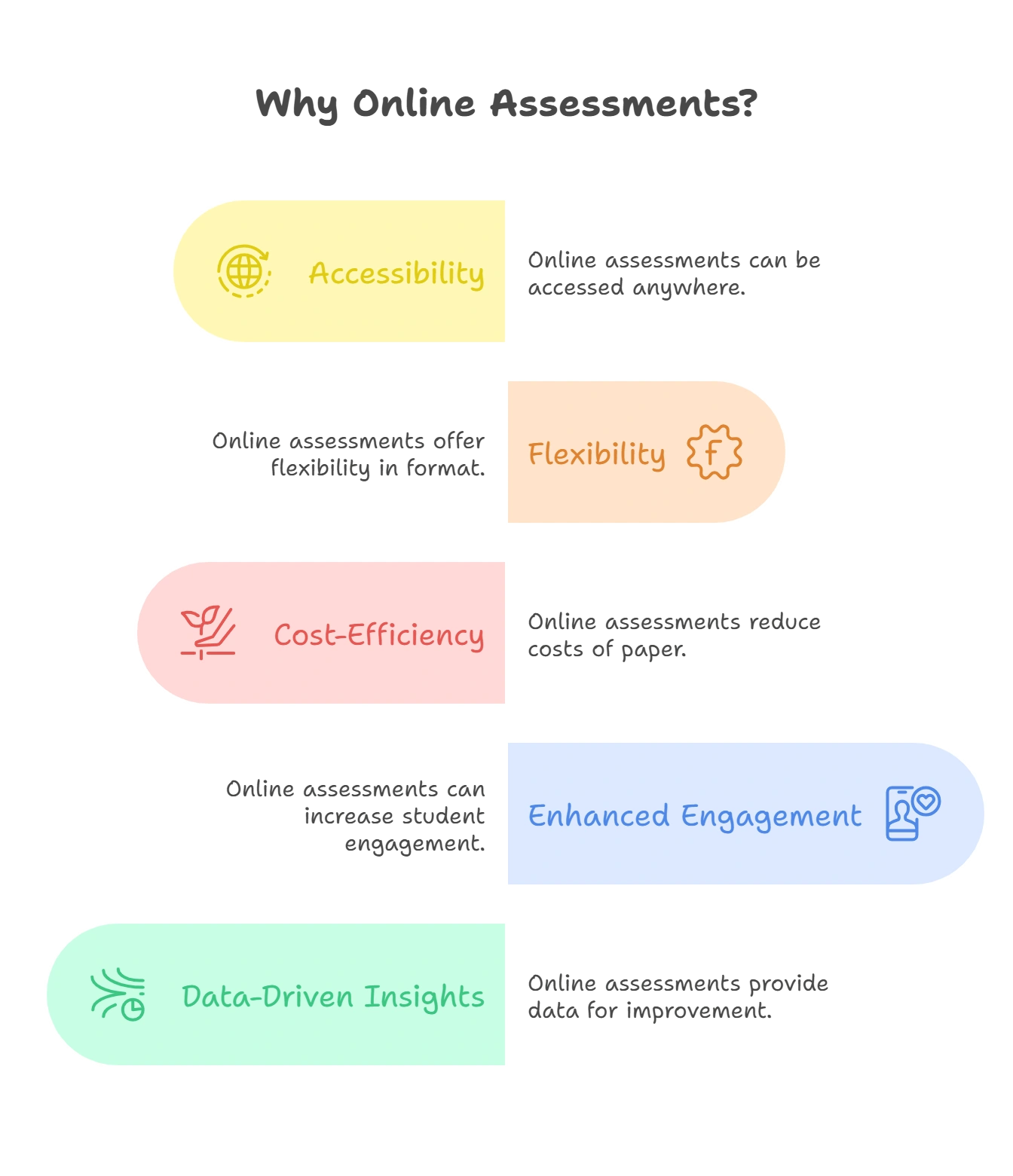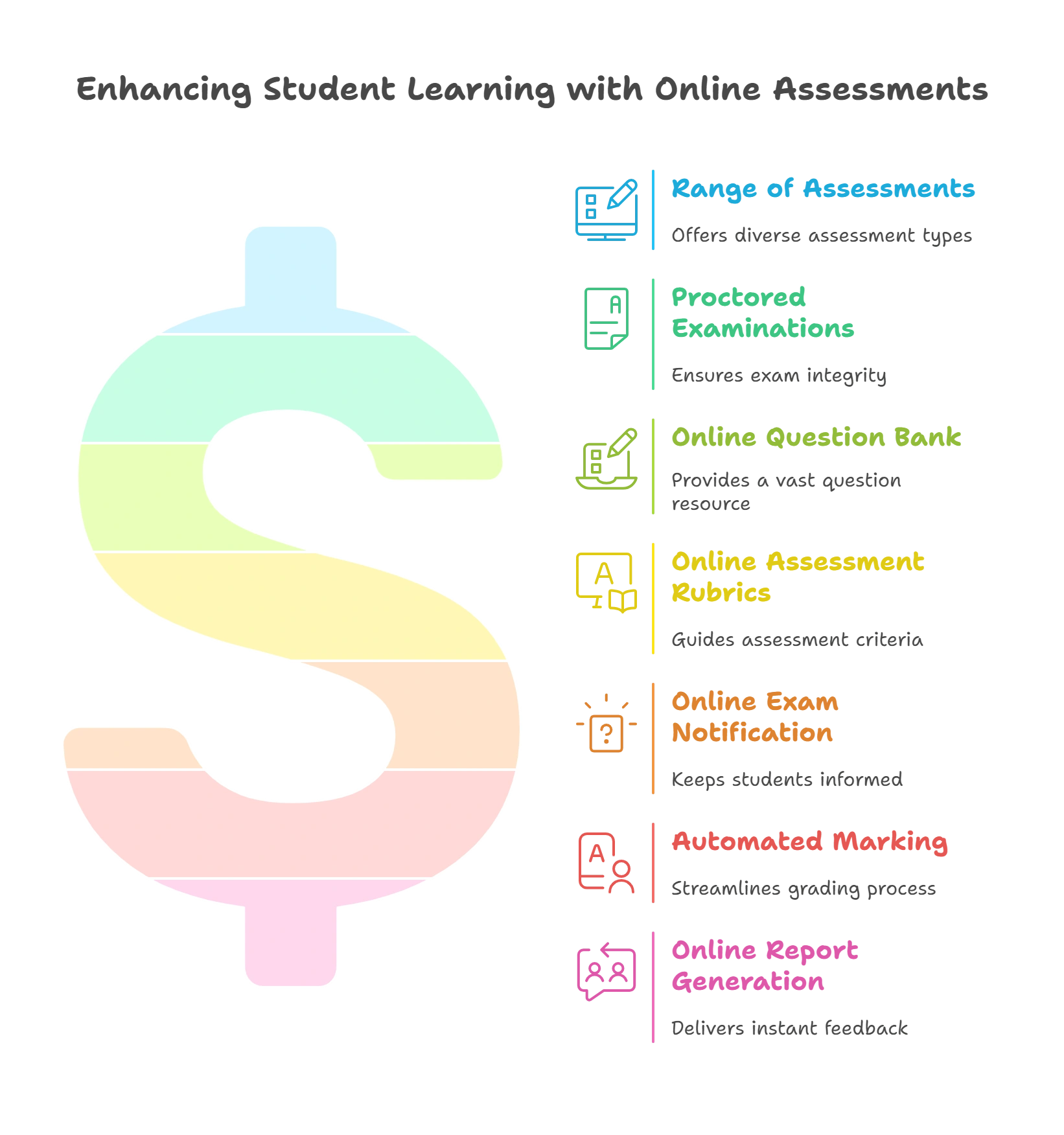
Why Educators are Ditching Paper for Online Assessment Tests?
Summarize with:
The world of education has changed drastically, and we are not just talking about the growing popularity of eLearning. As per a report by McKinsey, the overall enrollment for universities declined by 3% in 2021. Meanwhile, the enrolments at the largest online universities are up by 11%, with the number of learners enrolled in online courses increasing from 300,000 in 2011 to 220 million in 2021. This shows that the future of learning will be digital, but it also needs to be self-paced, agile, and flexible to meet the unique demands of learners. To match the pace of today’s digital education, online assessment tests are needed. Instead of the traditional pen-and-paper exam that was proctored in a physical classroom, online assessments offer a myriad of benefits, not just to students but also to teachers.
If you are unsure about embracing online assessment tests, here is a detailed blog on understanding what they offer and their advantages over offline assessment tests.
Table of Contents:
- What are Online Assessments?
- The Story So Far: A Rapidly Growing Industry
- Why Online Assessment Matters?
- Online Assessments Vs. Offline Assessments
- Benefits of Online Assessment for Students
- Final Thoughts
What are Online Assessments?
Online assessment tests are similar to offline tests but allow students to take exams or assessments via an internet-connected device.
To take an online exam or test, students must log in to the assessment platform using their device (ideally a laptop or desktop). Once logged in, they can answer the questions in the test, which can be multiple-choice, short answers, fill-in-the-blanks, long answers, or a combination of these. When the assessment is complete, the results are automatically recorded and can be reviewed by the teacher.
Online assessments help to measure the student’s knowledge, understanding of the topic, and skills in the required domain.
The Story So Far: A Rapidly Growing Industry
The digital age has made assessments more inclusive and convenient. From pandemic-induced transitions to long-term adoption in schools and workplaces, the shift is not just a trend but a necessity.
Here’s what the numbers tell us:
- The global online assessment market is anticipated to reach roughly $7.27 billion by 2030, with a CAGR of 9.1%.
- According to a report, 73% of students prefer online testing over traditional methods because of instant feedback and flexibility.
- A survey revealed that 80% of US Fortune 500 companies consider online skills assessments to be a vital part of recruitment and upskilling processes.
These figures underscore that the demand for online assessment in education and professional sectors isn’t just growing; it’s exploding.

Why Online Assessment Matters?
The allure of online assessment tools of evaluation lies in their benefits. Let’s explore why institutions, educators, and even learners are rooting for this revolution.
1. Accessibility for All
Geographical boundaries? Irrelevant. Time zones? A thing of the past. Whether you’re studying in a remote location or working on a different continent, online assessments ensure equal opportunities for all.
2. Flexibility in Format and Timing
Morning person or night owl? Online assessments let you choose when and where to take the test. The days of rigid schedules are behind us.
3. Cost-Efficiency
Say goodbye to expenses on printing, logistics, and proctoring. Organizations and institutions save resources, while learners save on travel and material costs.
4. Enhanced Engagement
Interactive elements, gamified quizzes, and multimedia integration make assessments engaging rather than nerve-wracking.
5. Data-Driven Insights
With tools offering in-depth analytics, educators can tailor learning experiences and focus on areas needing improvement. For organizations, these insights help shape effective training modules.
Online Assessments Vs. Offline Assessments
Now that we know how online assessment tests work, let us look at some key differences between online and offline assessments. In this section, we will also cover the advantages and disadvantages of online assessment.
| Parameters | Online Assessment Test | Offline Assessment Test |
| Flexibility & Convenience | The key benefit of online assessments is their flexibility and convenience. They can be completed from anywhere, at any time, and using digital devices makes them ideal for most students. This helps make learning more personalized and accommodates diverse schedules and learning needs. | Offline assessments require students to be physically present in the exam hall or classroom at a specific time. This makes it inflexible and can often be a predicament for students with conflicting schedules. |
| Immediate Feedback | Since the answers are instantly stored and automatically graded, online assessments can offer prompt feedback to students to help identify strengths and weaknesses in real-time. Thus, there are several benefits of online assessment for students, such as encouraging self-reflection, timely course correction, and a deeper understanding of the subject matter. | Since the grades and results are done manually, immediate feedback is almost impossible. The grading and result compilation process can often take a few days or weeks for larger institutions. This delays the learning process, and students may move on to a new topic before getting their assessment results, making it hard to comprehend previous mistakes or course corrections. |
| Learner Experience | Online Assessment Tools often have interactive features such as multimedia content, gamification elements, immersive experiences like interactive quizzes, timed challenges, and others that make them more engaging. | Traditional assessments are limited due to the pen-and-paper format. Plus, there is a complete absence of multimedia resources or interactive features, which makes it less engaging and often tiring. |
| Detailed Analytics & Reports | These tests include an online student progress tracker and other real-time data that teachers can access, such as time taken, grades, areas of improvement, etc. These advanced reports help teachers provide detailed guidance and tailor teaching strategies to student needs. | Offline assessments lack comprehensive data analytics and reporting capabilities, requiring manual grading and result compilation. |
| Accessibility | Online assessments can be provided with text-to-speech features, adjustable font sizes, or alternative formats to support learners with special needs. | While offline assessments can be tailored for those with special needs, providing tailored accommodations on a large scale is challenging. In addition, physical limitations and constraints can often hinder inclusivity in the evaluation process. |
| Cost & Resource Requirements | Digital assessment tools can require an initial investment, but they can significantly reduce assessment costs in the long run. | Offline assessments require no initial cost but incur ongoing expenses, such as logistical arrangements, printing materials, and other physical resources. In addition, the need for invigilators and examiners at the physical location also adds to the overall budget. |

Benefits of Online Assessment for Students
Online assessment tests are time-saving, cost-effective, and offer a host of other benefits. eLearning platforms are revolutionizing the way people educate themselves.
1. Range of Assessments
With the availability of digital assessment tools for teachers and appropriate software, it is possible to prepare a range of assessments using online assessment tests.
- Summative Assessments
Summative assessments assess both the educational program and the participants’ learning. They are conducted at the end of the learning term and include mid-term, half-yearly, and end-of-term exams. Projects and assignments are also included in this category.
Online assessment tools can help teachers develop quizzes, activities, and other engaging content. Furthermore, they can create summative assessments more comprehensively, allowing for modules that analyze students’ critical thinking skills and ability to communicate effectively.
- Formative Assessments
Formative assessments include a range of formal and informal assessments that aim to monitor student learning and provide ongoing feedback. The feedback is used to improve the instructors’ teaching methods and enhance the students’ learning experiences.
Formative assessments also help students identify their strengths and areas that they need to focus on more. Using different types of formative tests helps teachers determine the comprehension capacities and understanding capabilities of different students.
By utilizing a student progress tracker online, educational institutions can easily carry out formative assessments and track whether students are performing well or not.
2. Proctored Examinations
Proctored examinations are timed examinations in which the students are monitored and authenticated while they take the examination. In online proctored examinations, the students are monitored using computers, webcam video, and audio.
The proctoring software records the data and transfers it to a proctoring service for review. An online infrastructure supports all the activities in an online assessment test. The online examination proctoring market is predicted to reach US$ 1,742.95 million by 2028.
There are security concerns about students cheating in remote examination systems. However, by integrating proctoring software, one can authenticate online assessment tests.
Audio and video features can capture the students’ movements throughout the examination to ensure that they maintain the code of conduct and don’t cheat.
- Authentication of students
- Real-time monitoring of students
- Raising flags in real-time
- Availability of data for later review
3. Online Question Bank
In traditional education, teachers typically prepare question papers by typing down questions after referring to books, course materials, and the previous years’ question papers. This process is tedious and time-consuming.
However, in online assessment tests, the questionnaires are stored online, making it extremely simple for the instructors to access them when and as needed. Another benefit of using eLearning assessment tools is that multimedia questions can be asked in the examination. Instructors can create questionnaires with audio, video, and text options with the help of these tools.
4. Online Assessment Rubrics
A rubric is a set of criteria used for assessing learners’ performance. It provides more details than just marks or grades and is more objective. Online assessment rubrics are highly efficient for assessing online examinations.
Not only do they increase objectivity and reduce subjectivity, but they also reduce grading time and address a few other issues related to traditional assessment. They convey timely feedback to students and help them understand which areas need more focused attention. Rubrics typically include levels of performance and descriptors, presented as a grid-type structure.
Some common rubrics that instructors often use:
- Analytic Rubrics
- Developmental Rubrics
- Holistic Rubrics
- Checklists
5. Online Exam Notification
One of the major benefits of using online assessment tests is that students can be easily notified of the exam dates. Traditionally, students had to check the college or university notice boards for exam schedules, and there was the risk that someone could miss the notification.
However, with online assessment tests, the exam notification also happens online, and every student is notified of the exam schedule through emails and text messages. Educational institutions now have the option of sending notifications and alerts to students through various communication channels.
In the case of younger students, their parents can access the school’s online portals to check the exam schedule.
6. Automated Marking
Automated marking software programs are among the most useful digital assessment tools for teachers. Unlike in traditional education, where teachers were expected to dedicate several hours to checking and grading examination papers, in online education, marking can be easily automated using appropriate software.
Students take online assessment tests electronically. These papers are then marked by software capable of accurately checking the answers. The automated marking facility speeds up the checking process and is more accurate than human teachers.
The performance report is also generated online, and the students can log in using their credentials to access their reports.
7. Online Report Generation
In recent years, educational institutions have increasingly used online assessment tests and report generation. A student tracking system equipped with analytical tools can help generate accurate reports on students’ academic performance.
Besides report cards, it is also possible to create graphs and detailed charts to track the students’ performance over time and gain proper insight into their learning journeys.
Final Thoughts
The future of online assessments is not just about tests but the integration of all assessments into learning ecosystems. By adopting creative online assessment tools for evaluation, educators and organizations are undoubtedly investing in the future: learning has no end; it is tailored to each person and is inclusive.
Online assessment is still in its infant stages, and the possibilities are limitless. Whether a learner is looking to learn some new things, a teacher is yearning to teach, or an individual desires to upskill themselves, it has something extra-special in store for everyone.
Looking for creative ways to transform your learning and content delivery? Hurix Digital is a trusted partner for organizations worldwide that seek leading-edge solutions in eLearning development, content digitization, and online publishing.
Learn how we can help you stay ahead by concentrating on scalability and engagement.
Summarize with:

Senior Vice President
A Business Development professional with >20 years of experience with strong capability to sell new solutions and develop new markets from scratch. New Market Entry Specialist with experience working in the largest emerging markets. Exceptional experience in conceptualizing, ideating and selling new learning technologies like VR AR, etc. across multiple industry verticals.
 Upcoming Masterclass | Build an Army of Brand Evangelists using Training & Development | November 20th, 8:30 AM PDT | 11:30 AM EDT | 10:00 PM IST
Upcoming Masterclass | Build an Army of Brand Evangelists using Training & Development | November 20th, 8:30 AM PDT | 11:30 AM EDT | 10:00 PM IST





